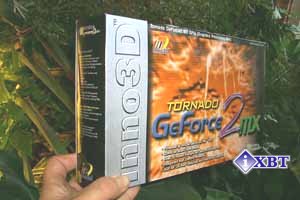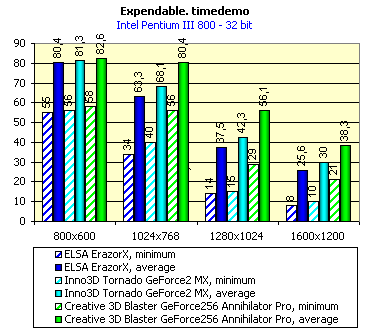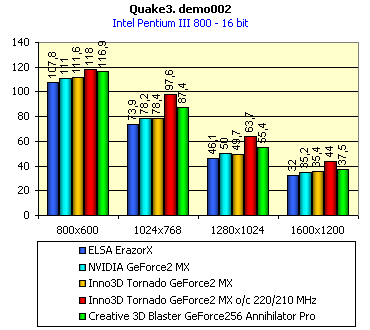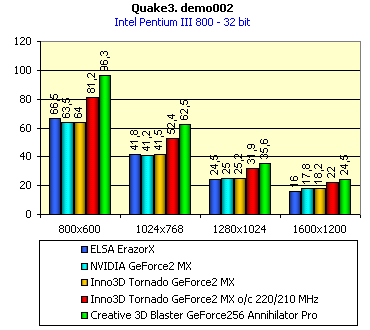 |
||
|
||
| ||
Some time ago we examined the ASUS AGP-V7100 series videocards which represent the new NVIDIA GeForce2 MX graphics chip in the market. The similar cards are intended for the sectors of rather cheap computer systems, and at the same time they possess significant game properties. As it was mentioned in the previous review the high quality 2D and 3D-graphics sometimes even higher than for NVIDIA GeForce256 SDR in combination with the low price will make such cards popular among the customers with average requests. I want to mark that the similar cards have already appeared in the market, and their cost is sometimes even lower than for the cards based on NVIDIA GeForce256 SDR. Therefore I can mark that the advantages of the NVIDIA GeForce256 SDR based graphics cards can be already evaluated by the user in practice. We are continue examining the serial videocards based on NVIDIA GeForce2 MX which began to appear in the market and on sale. I have already written about the Innovision Multimedia company in the review on its Inno3D Tornado GeForce2 GTS/64 videocard , and I shall only add that this manufacturer is widely known in the market of videocards in its "lowest" sector. Though the company is taken up a position in the market of videocards for a long time and occupies there a rather significant sector, we know in its fulfilment only the cards on low-end chips such as NVIDIA Riva TNT2 M64, Vanta. Unfortunately for many users the name Innovision is associated with noname - videocards of the Chinese production and so of rather bad quality. And really a lot of models from this manufacturer have very mean quality in 2D-graphics. Before the release of the boards on NVIDIA GeForce256/GeForce2 chips practically all the manufacturers changed the videocard design in their own way that sometimes only worsened their operation quality. What's more very cheap materials of rather bad quality were used for wiring on boards. All this led to the forming of the common name "innovision" for the users which sometimes was used for all noname-videocards of the last years. Taking into account that the released videocards based on NVIDIA GeForce256/GeForce2 practically do not differ from reference card I supposed that the videocards from Innovision Multimedia based on these chips can rise the reputation of the manufacturer among users. And it was confirmed by the card based on NVIDIA GeForce2 GTS. Therefore I began to probe one more novelty from Innovision Multimedia - the videocard based on NVIDIA GeForce2 MX with enthusiasm. I won't shall analyse in detail the possibilities and features of the NVIDIA GeForce2 MX chip. The main feature of this chip is the approximately 2 times lower 3D performance (for example 2 instead of 4 rendering pipelines and the reduced frequency in 175 MHz against 200 MHz for GeForce2 GTS). However the largest minus for similar cards is not this limit but rather slow SDR-memory installed on the boards. I think that the interested reader had time to get acquainted with our materials on NVIDIA GeForce256 SDR - videocards when the video memory capacity was compared with the narrow neck of the huge bottle. The geometry processor can not realise its potential at the slow video memory even it is very powerful. When I examined the videocards on NVIDIA GeForce2 GTS, this question was also discussed because disbalance of such cards in this aspect caused not only puzzle but even annoyance. Let's recollect the specifications for NVIDIA GeForce256 SDR. The core clock - 120 MHz, the memory - 166 MHz. Nowadays we have for GeForce2 MX core clocked at 175 MHz and the memory - at the same 166 MHz. As we can see the disbalance of such videocards is even higher. That's why even before testing it is possible to assume that the GeForce2 MX results will be close GeForce256 SDR. Especially it can be related to 32-bit colour which memory capacity causes most of remarks. However the slow memory installed on the cards makes them rather cheap. Furthermore the videocards on NVIDIA GeForce2 MX have higher quality of 2D-graphics than cards on GeForce256 SDR, and they also contain a lot of potentials, for example by the way of Twin View technology. Therefore we can not give the single-valued evaluations to such cards, and a lot of things will depend on concrete models. The cardThe basic characteristics of Inno3D Tornado GeForce2 MX:
Let's look at the card now: The card has AGP2x/4x interface, 32 MBytes 6 ns SDR SDRAM memory placed in 4 chips, posed on the face PCB:  The memory chips are produced by Samsung and designed for 166 MHz operating frequency. The memory functions on this frequency. I am impressed by the dimensions of this card! Not long ago only VGA-cards from Realtek with 256 KBytes on board have a such small PCB. And now the modern and most powerful device has the same gabarits: I compared the dimensions of the Quantum3D Obsidian2 X-24 which was so impressive not long ago with the given board. And you see only 2 years ago Obsidian was inaccessible not only on power in 3D but also just on dimensions:). Time passed by memory chips became smaller and one-chip-based card has even better performance than 6-processor one before, the memory "was minimised" too... One of my friends looking at Inno3D Tornado GeForce2 MX said that he would not install such card for himself because it doesn't accord with the solid appearance of the system block. The active cooler which we have already seen on many videocards was not installed on the given board but the heat sink is fixed on PCB to cool the chip. By everything NVIDIA recommends to all manufacturers to use heat sinks for cooling because of the absence of the chip strong overheat. This problem was already mentioned by me in the last material on NVIDIA GeForce2 MX, therefore I can only state that almost all manufacturers refuse to install the fan on such cards. We can also see that the company used the reference design to make this card manufacture, first of all for the arrangement of memory microcircuits. The board is deep yellow. There is a free place on a PCB for a digital flat panel connector. The videocard is delivered in the box of bright design:  You can find not only the user's guide, CD - disk with drivers and utilities, but also some additional software in the box:
Moreover the complete version of MadOnion 3D Mark2000 Pro is delivered on the CD - disk with drivers and utilities. It is also possible to find two paper blocks for notes with the firm trade mark. I can't help praising the manufacturer for such excellent delivery! OverclockingIt is interesting to mark that as against videocards based on NVIDIA GeForce256 SDR where 5 ns memory operating on the reduced frequency (166 MHz) are used as a rule in this case 6 ns memory operating on the nominal frequency (166 MHz) without store are installed. Then I can state that overclocking of memory won't be so high as it is desirable. The frequency and the memory operation rate play the main role on these cards. Nevertheless the frequency 210 MHz on memory was not got by us. We managed to overclock the chip up to 220 MHz (from the default 175Mhz!) that confirms the excellent potential of similar chips based on 0.18 micron technology. As of today such overclocking of a card on NVIDIA GeForce2 MX is record. Therefore we should expect some increase in performance of this card operating on non-default frequencies at 32-bit colour and the essential increase at 16-bit colour. Installation and driversNow here is the practical part of our review... For the beginning I shall present the test configuration: Pentium III based test system configuration:
ViewSonic P810 (21") monitor was used at this test configuration. Innovision Multimedia delivers the reference NVIDIA 5.22 drivers with the videocard, therefore I shan't examine them in detail. Everybody can acquaint with the description of configuration in our reviews. I shall only mark that the we used the newer 5.33 drivers from NVIDIA for testing. 6.* drivers from NVIDIA appeared after we completed all the tests of this card, therefore they are not examined here. Take a look at the current issue of 3Digest. Test resultsWe shall begin with 2D-graphics. In the previous article I have already marked the high quality and very good speed in 2D-graphics which were demonstrated by the cards based on GeForce2 MX from NVIDIA. And now I can state with pleasure that all Inno3D Tornado GeForce2 MX results in 2D are not worse than the results of other boards of this class (the reference design from NVIDIA has an effect). As well as in the case with Inno3D Tornado GeForce2 GTS/64 I can state: the videocard Inno3D Tornado GeForce2 MX as well as the rest representatives of such cards will meet the image quality needs for the majority of the users. We shall examine Inno3D Tornado GeForce2 MX performance in 3D using two games:
These instruments are quite enough to show the videocard performance at operation through two fundamental APIs. The performance results of three graphics card are compared on the diagrams: ELSA ErazorX (based on NVIDIA GeForce256 SDR), the reference card NVIDIA GeForce2 MX and Creative 3D Blaster GeForce256 Annihilator Pro (based on NVIDIA GeForce256 DDR). Also we shall show how the videocard Inno3D Tornado GeForce2 MX performance has changed in the overclocking mode.     It is easy to note that Inno3D Tornado GeForce2 MX performance in whole practically do not differ from the results of NVIDIA GeForce2 MX refernce card, very slightly anticipating the competitor powered by NVIDIA GeForce256 SDR and strongly lagging behind the NVIDIA GeForce256 DDR based card. Such results are quite prognosticated taking into account bandwith of the video memory. And even the overclocking of Inno3D Tornado GeForce2 MX could not provide the victory in 32-bit colour for this card. But in 16-bit colour Inno3D Tornado GeForce2 MX operating on overclocked frequencies could become the winner. I shall mark that the card from Innovision Multimedia worked with minimum additional external cooling (only one additional fan for good air circulation was installed in the system block). Certainly I can not extrapolate the given card overclocking results on all cards based on GeForce2 MX, however we can hope that overclocking fans can find the proper copy for their needs. As for playing DVD-Video then everything is like for all videocards on NVIDIA GeForce2 GTS. InterVideo WinDVD 2000 player delivered with the videocard was installed without problems, the image quality was just excellent, the processor utilization did not exceed 29%. In sort that Inno3D Tornado GeForce2 MX has no output for the second external signal receiver (second screen monitor, Tv-out, DVI), the TwinView technology remained overboard of the given material. ConclusionSo Inno3D Tornado GeForce2 MX card is the second representative of cards from Innovision Multimedia based on the latest chips from NVIDIA - GeForce2 GTS/MX. As we saw this card is as well as its analogs. In spite of the fact that its performance in most cases is at the level NVDIA GeForce256 SDR or a little higher, the card has rather low cost ($120 by the middle of August) that will make this card to be in demand. We shouldn't forget about the increased quality of 2D-graphics for similar cards relative to NVIDIA GeForce256 and about the additional improvement through DVC. This card will have a success among the customers because of such magnificent delivery and the lowest price for cards based on GeForce2 MX. I want to mark that Inno3D Tornado GeForce2 MX card has great overclocking possibilities but overclocking potential depends on the concrete copy. Pros:
Cons:
Write a comment below. No registration needed!
|
Platform · Video · Multimedia · Mobile · Other || About us & Privacy policy · Twitter · Facebook Copyright © Byrds Research & Publishing, Ltd., 1997–2011. All rights reserved. |